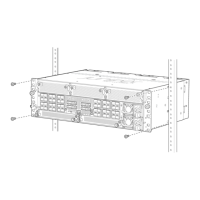NOTE: You must order cables with the correct polarity. Vendors refer to these crossover cables
as
key up to key up
,
latch up to latch up
,
Type B
, or
Method B
. If you are using patch panels
between two transceivers, ensure that the proper polarity is maintained through the cable plant.
The MPO opcal connector for the CFP2-100G-SR10-D3 is dened in
Secon 5.6
of the
CFP2
Hardware Specicaon
and
Secon 88.10.3
of
IEEE STD 802.3-2012
. These specicaons include the
following requirements:
• Recommended Opon A in IEEE STD 802.3-2012.
• The transceiver receptacle is a plug. A patch cable with a socket connector is required to connect to
the module.
• Ferrule nish must be a at-polished interface that is compliant with IEC 61754-7.
• Alignment key is key up.
The opcal interface must meet the FT-1435-CORE requirement in
Generic Requirements for Mul-
Fiber Opcal Connectors
. The module must pass the wiggle test dened by IEC 62150-3.
CS Connector
You can use patch cables with CS connectors to connect two supported transceivers of the same type-
for example, 2x100G-LR4 to 2x100G-LR4 or 2x100G-CWDM4 to 2x100G-CWDM4. CS connectors are
compact connectors that are designed for next-generaon QSFP-DD transceivers. The CS connector
provides easy backward compability with QSFP28 and QSFP56 transceivers.
LC Duplex Connectors
You can use patch cables with LC duplex connectors to connect two supported transceivers of the same
type—for example, 40GBASE-LR4-to-40GBASE-LR4 or 100GBASE-LR4-to 100GBASE-LR4. A patch
cable is one ber pair with two LC duplex connectors at opposite ends. LC duplex connectors are also
used with 12-ber ribbon breakout cables.
Figure 24 on page 63 shows how to install an LC duplex connector in a transceiver.
62

